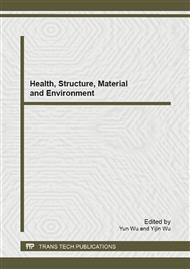[1]
Bo LI, Shuping LIU. The Technologies for Treating Wastewater Containing Copper and Research Progress. Multipurpose Utilization of Mineral Resources 2008; 5: 33-38.
Google Scholar
[2]
Qianqian LI, Yijiu LI, Bo XIANG. Application of the macromolecule-chelating agent to the treatment of heavy metal wastewater, Industrial water treatment 2004; 7: 5-8.
Google Scholar
[3]
Yufeng ZHONG, Shaolin WU, Yufen DAI, Ting ZHANG, Zhenxin ZHU. The Application of Chelating Agents in Disposing Heavy Metal Wastes. Jiangxi Science 2007; 25: 351-354.
Google Scholar
[4]
Yuxiu ZHANG, Zhibo HUANG, Tuanyao CHAI. Mechanism and Application of Chelator in Enhanced Phytoremediation of Heavy Metals Contaminated Soils: A Review. Progress in Natural Science 2009; 19: 1149-1158.
Google Scholar
[5]
Lihua ZHANG, Zhiliang ZHU, Ronghua ZHANG, et al. Extraction of copper from sewage sludge using biodegradable chelant EDDS. Environmental Sciences 2008; 20: 970-974.
DOI: 10.1016/s1001-0742(08)62195-6
Google Scholar
[6]
Dorota Kołodyńska. Application of strongly basic anion exchangers for removal of heavy metal ions in the presence of green chelating agent. Chemical Engineering 2011; 168: 994–1007.
DOI: 10.1016/j.cej.2011.01.073
Google Scholar
[7]
Minhong ZHANG, Yanping WAN and Baoji SUN. Study on synthesis of Ethylenediaminedisuccinic Acid. Water Treatment China 2008; 11: 54-58.
Google Scholar
[8]
Dorota Kołodyńska. Green complexing agent — EDDS in removal of heavy metal ions on strongly basic anion exchangers. Desalination 2011; 280: 44–57.
DOI: 10.1016/j.desal.2011.06.060
Google Scholar
[9]
Xiaoxia HUANG, Ru LIU. Batch Adsorption and Mechanism of Chromium (VI) Removal from Aqueous Solutions by Strongly Basic Anion Exchange Resin 201×4. Guangdong chemical 2010; 5: 86-89.
Google Scholar
[10]
Tarek S. Jamil, Tarek A. Gad-Allah, Hanan S. Ibrahim, Tamer S. Saleh. Adsorption and isothermal models of atrazine by zeolite prepared from Egyptian kaolin. Solid State Sciences 2011; 13: 198-203.
DOI: 10.1016/j.solidstatesciences.2010.11.014
Google Scholar
[11]
Pinhua RAO, Wenqi ZHANG, et al. Study on Simultaneous Removal of Multiple Heavy Metals from Water by Aalumina. Technology of Water Treatment 2009; 35: 71-74.
Google Scholar
[12]
Chung-Hsin Wu, Cheng-Fang Lin, Hwong-Wen Ma, et al. Effect of fulvic acid on the sorption of Cu and Pb onto γ-Al2O3. Water Research 2003; 37: 743–752.
DOI: 10.1016/s0043-1354(02)00391-3
Google Scholar
[13]
Guixian WANG, Qiwei ZHANG. Study on Adsorption Property of Bamboo-charcoal for Cu (II). Journal of Shenyang University of Chemical Technology 2010; 24: 126-129.
Google Scholar
[14]
Selvaraj Rengaraj, Younghun Kim, Cheol Kyun Joo, and Jongheop Yi. Removal of copper from aqueous solution by aminated and protonated mesoporous aluminas: kinetics and equilibrium. Colloid and Interface Science 2004; 273: 14–21.
DOI: 10.1016/j.jcis.2004.01.007
Google Scholar
[15]
Yaolan NIU, Dengxin LI, Chengyu MA and Laisheng LUO. Preparation of activated carbon from hemps and their adsorption on Cu2+. Chinese Journal of Environmental Engineering 2010; 4: 2848-2852.
Google Scholar


